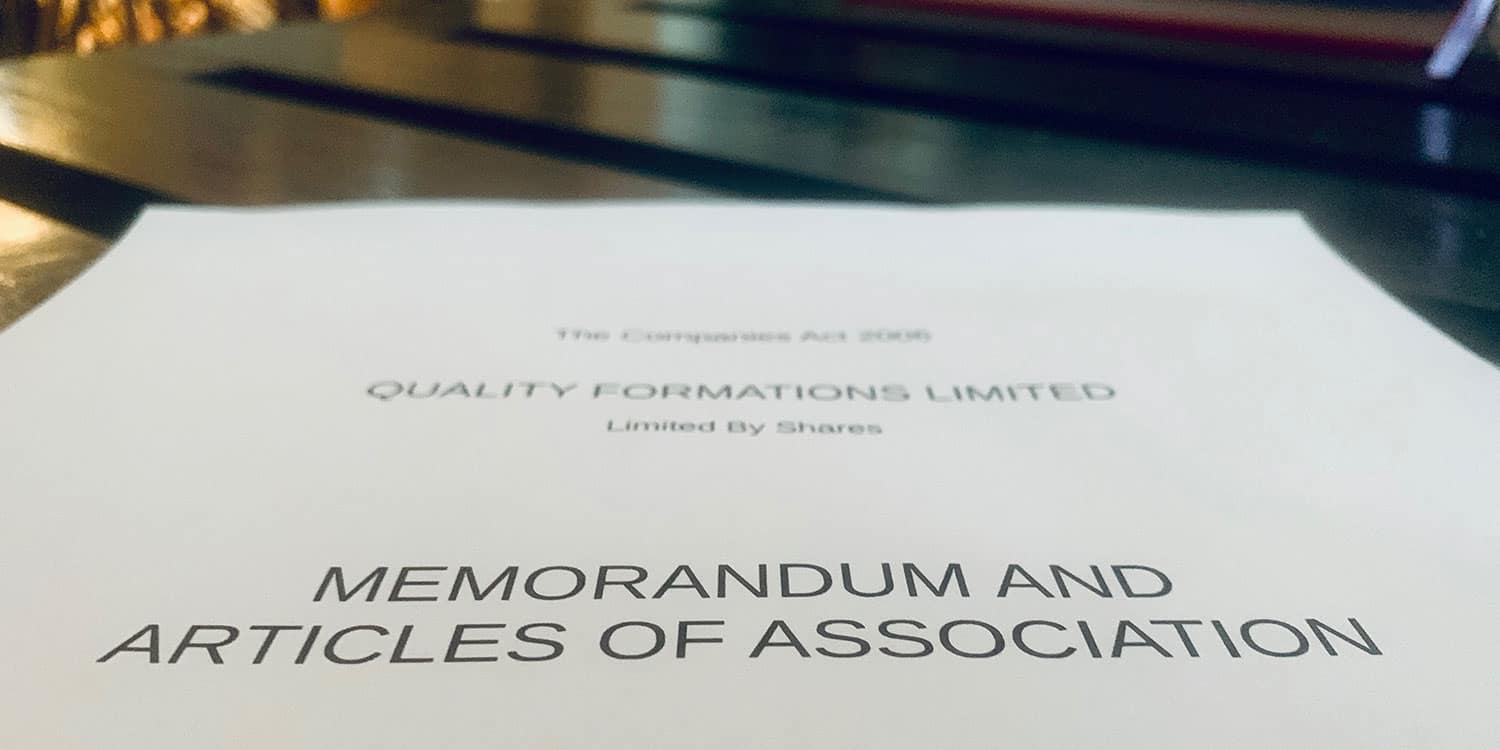

Company Formation 5 Min Read
The memorandum and articles of association are two essential documents required to set up a limited company in the UK. They are both issued during the company formation process and become a matter of public record thereafter. Below, we explain these important company documents in detail.
The memorandum of association is a single-page document that records the names of the subscribers (founding shareholders or guarantors) and their formal agreement to become members of the company.
The articles of association is a multi-page document that outlines the rules and restrictions relating to the way the company is governed, operated, and owned.
The memorandum of association confirms that the founding members agree to set up and join the company under the Companies Act 2006. Within the memorandum of a company limited by shares, the shareholders also undertake to hold a minimum of one issued share each.
The maximum number of shares each subscriber agrees to take will vary on a case-by-case basis, depending on the total issued share capital of a company.
The memorandum is a document created by Companies House during the incorporation process and includes a statement of compliance of each subscriber. Companies House will attach this document to the adopted articles of association, as part of the application to register the company.
Prior to the introduction of the Companies Act 2006 on 1st October 2009, limited companies were incorporated under the Companies Act 1985. At that time, the memorandum also included a number of governing provisions that are now part of the articles of association (including the company’s objects).
These rules and restrictions for companies registered under the old Act are now treated as being part of the articles, rather than the memorandum.
The articles of association is a governing constitutional document adopted by a limited company when it is formed at Companies House.
It includes key information about how the company should be run, how decisions are made, who can own and manage the company, the rights and responsibilities of members and directors, and the types of activities and transactions in which the company can engage.
Unlike the memorandum, the articles of association do not have a prescribed format. Companies can choose to:
Model articles are the standard, default articles that companies can use. They are prescribed by the Companies Act 2006 and used by many new companies. Companies House offers different Model articles for private companies limited by shares, private companies limited by guarantee, and public limited companies.
The need to alter the Model articles or create bespoke articles is less common but may be necessary if you want to restrict or enhance directors’ powers, issue more than one class of share, or alter the rights attached to Ordinary shares, for example.
The Model articles for companies limited by shares are only suitable if you issue only Ordinary shares that provide equal rights to all shareholders.
The contents of the Model articles of association for private companies limited by shares are:
1. Defined terms
2. Liability of members
3. Directors’ general authority
4. Shareholders’ reserve power
5. Directors may delegate
6. Committees
7. Directors to take decisions collectively
8. Unanimous decisions
9. Calling a directors’ meeting
10. Participation in directors’ meetings
11. Quorum for directors’ meetings
12. Chairing of directors’ meetings
13. Casting vote
14. Conflicts of interest
15. Records of decisions to be kept
16. Directors’ discretion to make further rules
17. Methods of appointing directors
18. Termination of director’s appointment
19. Directors’ remuneration
20. Directors’ expenses
21. All shares to be fully paid up
22. Powers to issue different classes of share
23. Company not bound by less than absolute interests
24. Share certificates
25. Replacement share certificates
26. Share transfers
27. Transmission of shares
28. Exercise of transmittees’ rights
29. Transmittees bound by prior notices
30. Procedure for declaring dividends
31. Payment of dividends and other distributions
32. No interest on distributions
33. Unclaimed distributions
34. Non-cash distributions
35. Waiver of distributions
36. Authority to capitalise and appropriation of capitalised sums
37. Attendance and speaking at general meetings
38. Quorum for general meetings
39. Chairing general meetings
40. Attendance and speaking by directors and non-shareholders
41. Adjournment
42. Voting: general
43. Errors and disputes
44. Poll votes
45. Content of proxy notices
46. Delivery of proxy notices
47. Amendments to resolutions
48. Means of communication to be used
49. Company seals
50. No right to inspect accounts and other records
51. Provision for employees on cessation of business
52. Indemnity
53. Insurance
It is important to be aware of the content of the Model articles before agreeing to adopt them. For example, they give the directors wide ranging powers. If you wish to put certain restrictions in place, such as limiting the directors’ powers or requiring that they seek approval from members before authorising certain actions, you will need to alter the articles accordingly.
It is commonplace for shareholders to draw up a formal Shareholders’ Agreement to supplement the provisions in the articles in relation to the way the company is run, the powers of members and officers, and the issue or transfer of shares. Unlike the articles, a Shareholders’ Agreement is optional and not a matter of public record.
If you set up a company with more than one shareholder, we highly recommend entering into a Shareholders’ Agreement to protect and clarify the rights of each member.
If you wish to alter your articles of association or adopt new articles after company formation, the members will be required to pass a special resolution to approve the change. You will then have to send a copy of the resolution and the new articles to Companies House.
A copy of the final document as altered must be submitted to Companies House within 15 days of the resolution.
If you need to change the company’s objects (i.e., what the company does) within the articles, you will need to complete Form CC04 and send it to Companies House with a copy of the special resolution and the articles as altered.
If you register a company through a company formation agent, you will receive copies of your memorandum and articles of association when your company registration has been approved by Companies House. These documents will be sent to you by email, along with your certificate of incorporation and share certificates.
Alternatively, you can view and download digital copies of your memorandum and articles of association, as well as other company documents, via Companies House WebCHeck or Companies House Service (formerly known as Companies House BETA).
Quality Company Formations customers can also view their memorandum and articles of association online by signing into their client account on our online Company Manager Portal.
Share this post
Nicholas Campion is a Chartered Secretary and Governance Professional with a decade’s experience in the corporate services industry. Having established and grown the company secretarial function at QCF, he has built extensive knowledge in company formation, secretarial and legal matters. He is also deeply familiar with trends in UK business and provides regular commentary on how new and existing businesses can remain compliant.